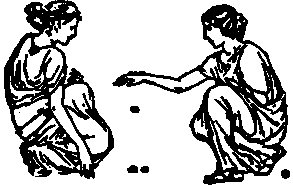Knucklebones, or more properly "tali", were used by adults for gambling and by children for a game that later evolved into jacks. They were made from the knucklebones or talus of sheep and goats, but imitations made of bronze, stone and ivory were also used.
 For those unfamiliar with sheep anatomy and wondering what these game pieces looked like, they are longer than they are wide. Each tali has four long sides and two short ones, forming a rectangular solid. The short sides were rounded off so the tali couldn’t stand on end. Of the four long sides, two were broader. One broad side was convex, the other concave. One narrow side was flat, the other intended. So we have four easily identifiable sides. They were sometimes numbered nonetheless, 1, 3, 4, and 6. Two and five were omitted, probably being the numbers of the rounded ends. The game pieces can easily be made from wood scraps or Sculpey, an oven-hardening clay available in the craft section at Wal-Mart.
Children played by tossing five tali into the air and trying to catch as many as possible on the back of one hand.
Adults used them for a game similar to dice in which four tali were thrown either from the hand or a dice box. Players placed bets; the side the bone rested on was counted rather than the side that faced upward. Thirty-five different throws were recognized. The lowest throw was four ones and was called a Vulture. The highest was a Venus and occurred when all four tali landed on a different side.
Johnson only names two of the thirty-five combinations. If you know of more, please send in your information and source!
Source: Johnson, Mary Roman Life. Scott, Foresman & Co., 1957.
For those unfamiliar with sheep anatomy and wondering what these game pieces looked like, they are longer than they are wide. Each tali has four long sides and two short ones, forming a rectangular solid. The short sides were rounded off so the tali couldn’t stand on end. Of the four long sides, two were broader. One broad side was convex, the other concave. One narrow side was flat, the other intended. So we have four easily identifiable sides. They were sometimes numbered nonetheless, 1, 3, 4, and 6. Two and five were omitted, probably being the numbers of the rounded ends. The game pieces can easily be made from wood scraps or Sculpey, an oven-hardening clay available in the craft section at Wal-Mart.
Children played by tossing five tali into the air and trying to catch as many as possible on the back of one hand.
Adults used them for a game similar to dice in which four tali were thrown either from the hand or a dice box. Players placed bets; the side the bone rested on was counted rather than the side that faced upward. Thirty-five different throws were recognized. The lowest throw was four ones and was called a Vulture. The highest was a Venus and occurred when all four tali landed on a different side.
Johnson only names two of the thirty-five combinations. If you know of more, please send in your information and source!
Source: Johnson, Mary Roman Life. Scott, Foresman & Co., 1957.